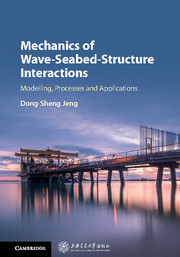Book contents
- Frontmatter
- Contents
- Preface
- 1 Overview
- 2 Basic Seabed Mechanisms
- 3 Soil Response in Marine Sediments under Combined Loading of Waves and Currents
- 4 Integrated Model of Wave-Seabed Interactions around Caisson-Type Breakwaters
- 5 Mechanics of Wave-Seabed-Pipeline Interactions
- 6 Three-Dimensional Model of Wave-Seabed Interactions around Breakwater Heads
- 7 Seabed Instability around Offshore Wind Turbine Foundations
- 8 Physical Modelling: One-Dimensional Compressive Tests
- Appendix A Analytical Solution for a Seabed of Finite Thickness (Hsu & Jeng 994)
- Appendix B Derivation of u–p Approximation (Jeng et al. 1999)
- Appendix C Derivation of u–U Approximation (Cha et al. 2002)
- Appendix D Mathematical Derivations of Analytical Solutions for Residual Soil Response (Jeng et al. 2007)
- Appendix E Mathematical Model of the Two-Layered Viscous Fluid System (Liu et al. 2009)
- References
- Author Index
- Subject Index
3 - Soil Response in Marine Sediments under Combined Loading of Waves and Currents
Published online by Cambridge University Press: 28 April 2018
- Frontmatter
- Contents
- Preface
- 1 Overview
- 2 Basic Seabed Mechanisms
- 3 Soil Response in Marine Sediments under Combined Loading of Waves and Currents
- 4 Integrated Model of Wave-Seabed Interactions around Caisson-Type Breakwaters
- 5 Mechanics of Wave-Seabed-Pipeline Interactions
- 6 Three-Dimensional Model of Wave-Seabed Interactions around Breakwater Heads
- 7 Seabed Instability around Offshore Wind Turbine Foundations
- 8 Physical Modelling: One-Dimensional Compressive Tests
- Appendix A Analytical Solution for a Seabed of Finite Thickness (Hsu & Jeng 994)
- Appendix B Derivation of u–p Approximation (Jeng et al. 1999)
- Appendix C Derivation of u–U Approximation (Cha et al. 2002)
- Appendix D Mathematical Derivations of Analytical Solutions for Residual Soil Response (Jeng et al. 2007)
- Appendix E Mathematical Model of the Two-Layered Viscous Fluid System (Liu et al. 2009)
- References
- Author Index
- Subject Index
Summary
Introduction
The co-existence of waves and currents in offshore areas is a common physical phenomenon and their interaction is an important topic in coastal and ocean engineering. The presence of a current in a propagating wave will change the original characteristics of wave. For example, the following current will elongate the wavelength, and the opposing current will shorten the wavelength. However, most previous studies of the soil response in marine sediments have considered wave loading only. In fact, the pressure acting on the seabed is significantly different when there is a current in the flow field, according to the potential flow theory. In Hsu et al.'s (2009) work, the thirdorder approximation for wave-seabed interactions was used to determine the dynamic pressures acting on the seabed surface for the porous seabed model. Later, the same analytical solution for wave-current interactions (Hsu et al. 2009) was used to develop analytical solutions based on the quasi-static approximation (Zhang, Jeng, Gao & Zhang 2013), the u–p approximation (Liu et al. 2014) and the u–U approximation (Liao, Jeng & Zhang 2015). A similar approach was adopted to examine the case of a fully buried pipeline (Wen, Jeng & Wang 2012).
In this chapter, the theoretical models of wave-current interactions are outlined first. Then the effects of currents on the oscillatory seabed response are investigated numerically by adopting the ‘u–p’ approximation (Biot 1956a; Zienkiewicz et al. 1980), in which the inertial terms of solid and pore fluid are both considered as the governing equations for a porous seabed. Based on the numerical model, the effects of current on seabed response are investigated; a parametric study is carried out to investigate the effects of wave and soil characteristics on the seabed response, as well as the liquefaction under combined loading of non-linear waves and currents.
Flow Models for Wave-Current Interaction
Analytical Solution: Third-Order Approximation of Wave-Current Interactions
In this chapter, to obtain more accurate results of seabed response under combined wave and current loadings, the third-order solution of wave-current interactions is used to determine the dynamic wave pressures acting on the seabed. For the problem of the third-order wave-current interactions, some works are available in previous literature. The interaction between a linear wave and a uniform current was studied by Thomas (1981). Baddour & Song (1990b) further investigated the interaction of linear waves and currents.
- Type
- Chapter
- Information
- Mechanics of Wave-Seabed-Structure InteractionsModelling, Processes and Applications, pp. 109 - 128Publisher: Cambridge University PressPrint publication year: 2018



